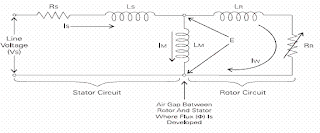VS Line voltage applied to stator power leads
RS Stator resistance
LS Stator leakage inductance
IS Stator current
E Air gap or magnetizing voltage
LM Magnetizing inductance
IM Magnetizing current
RR Rotor resistance (varies with temperature
LR Rotor leakage inductance
IW Working or torque producing current

Line Voltage Voltage (VS) is applied to the stator power leads from the AC power supply. Voltage drops occur due to stator resistance (RS).
The resultant voltage (E) represents force (cemf) available to produce magnetizing flux and torque.
Magnetizing Current Magnetizing current (IM) is responsible for producing magnetic lines of flux which magnetically link with the rotor circuit. Magnetizing current is typically about 30% of rated current. Magnetizing current, like flux (Φ), is proportional to voltage (E) and frequency (F).
Im = E / 2 * 3.14 * F * Lm
Working Current The current that flows in the rotor circuit and produces torque is referred to as working current (Iw). Working current is a function of the load. An increase in load causes the rotor circuit to work harder increasing working current (Iw). A decrease in load decreases the work the rotor circuit does decreasing working current (Iw)
.
Stator Current Stator current (Is) is the current that flows in the stator circuit. Stator current can be measured on the supply line and is also referred to as line current. A clamp-on ammeter, for example, is frequently used to measure stator current. The full-load ampere rating on the nameplate of a motor refers to stator current at rated voltage, frequency and load. It is the maximum current the motor can carry without damage. Stator current is the vector sum of working current (Iw) and magnetizing current (Im).Typically magnetizing current (Im) remains constant. Working current (Iw) will vary with the applied load which causes a corresponding change in stator current (Is).


No comments:
Post a Comment